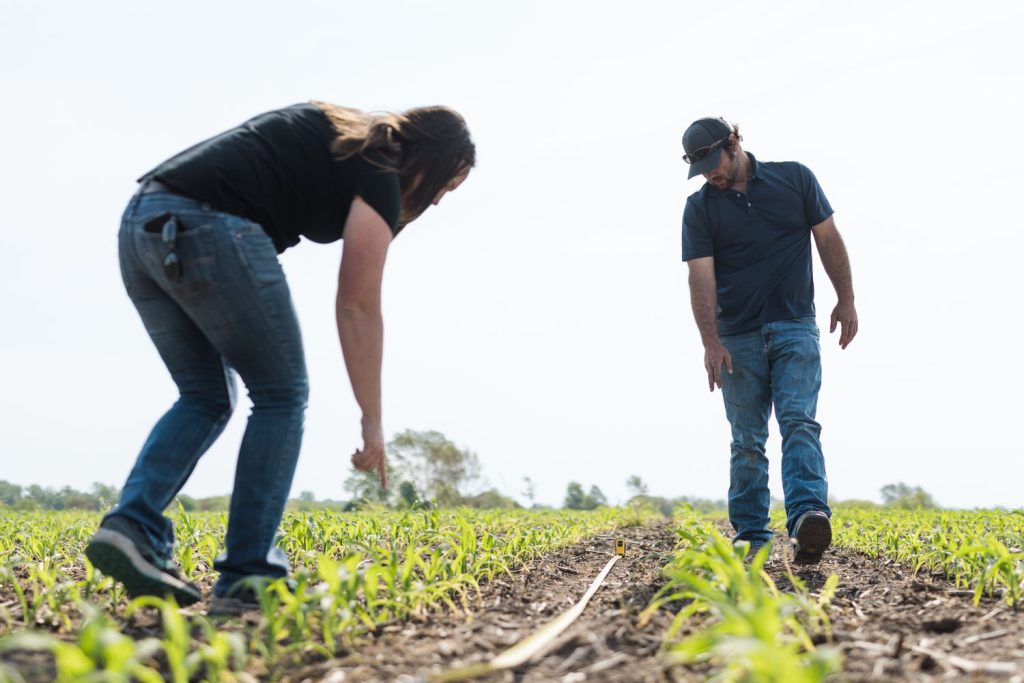Although it’s still early in the growing season, weed, insect, and disease pressures will soon emerge in young corn and soybean fields. Keeping detailed records of planting conditions, emergence rates, and stand counts equips farmers with expectations for the current crop, as well as valuable insights for improving decisions.
Get an Early Jump on Weeds
Early-season scouting can be a great way to determine preemergence herbicide efficacy and detect herbicide-resistant weeds.
To keep fields clean, Kevin Bradley, a University of Missouri Extension weed specialist, recommends a combination of cultural practices, such as cover crops, tillage, and weed seed destruction, as well as the use of herbicides to keep fields clean. Bradley points to the following practices for turning around weed management issues:
Use preemergence herbicides and postemergence herbicides at full label rates.Use multiple modes of action.Apply as close to planting as possible.
Bradley has also found that troubled fields can be improved by using a preemergence herbicide, followed by an effective postemergence-applied residual herbicide.
Reduce Insect Pressure
As crops begin to emerge, be alert to potential damage that early-season insects may cause, said Bob Wright, an entomology professor emeritus at the University of Nebraska.
“Wireworms and white grubs are common in fields that have been pasture or CRP for over a year, while winter annual weeds or abundant crop residue attract egg-laying black cut-worm moths in the spring,” Wright said.
Cutworms
In years when planting is delayed, corn emergence, dying annual weeds, and black cutworm development can coincide, putting corn at higher risk for damage.
“Early detection is crucial, as most cutting occurs within seven days of emergence,” said Christian Krupke, a Purdue Extension entomologist. “Consider treatment if 3%–5% of plants show cutting and worms are 1 inch or less.”
Viktor_Kitaykin, Getty Images
Wireworms
If you’re dealing with wireworms, there is no rescue treatment, Wright said. “They do all their feeding underground. The larvae can continue to hatch from eggs laid as long as six years ago, and they can start feed-ing as soon as seed hits the dirt,” he said.
“The use of seed treat-ments has greatly reduced the incidence of wireworm damage. They are excellent early-season stand protectors,” Wright said.
Courtesy of Frank Peairs, Colorado State University, Bugwood.org
Grubs
While you’re scouting, check for white grubs; they wait a little longer than wireworms to start feeding, can overwinter in the soil, and feed on roots up to corn’s six-leaf stage, Wright said. Like wireworms, there is no rescue treatment for white grubs. High-risk areas need to be treated at planting. Products for white grub control are similar to wire-worm control,” he added.
Slugs
Reports of slug damage have been increasing in recent years, said Kevin Gale, an agronomist for AgriGold. “We walked fields in 2023 that were decimated by slug damage due to the mild winter,” he said. “Slow growing conditions, especially no-till environments, are also prone.”
Slug treatments can be expensive, so Gale recommends residue management to help manage slugs. “Utilizing row cleaners to help get residue out of the row and planting into conditions where the plant can grow rapidly is important for managing slugs,” he said.
Bean Leaf Beetle
Bean leaf beetles may infest soybeans, especially in early or late plantings, said Todd Schomburg, who helped build Stine Seed and is now recruitment director. Adding an insecticide to seed treat-ment helps control them.
micreax, Getty Images
Thwarting Diseases With Seed Treatments
Identifying seedling diseases start with knowing what a healthy plant looks like. Search for yellowing, wilting, stunting, and miss-ing plants. In corn, check for discolored or rotten mesocotyls and roots. In soybeans, look for seedlings that pull easily, rotting root tissue, and taproot or hypocotyl lesions.
The longer conditions stay damp, the better the chance of crops, especially soybeans, developing disease problems. Diseases such as Pythium are more common in damp, cooler soils, while Phytophthora root rot hits harder when things warm, said Loren Giesler, a University of Nebraska Extension plant pathologist.
Typical symptoms of Pythium include seed decay, preemergent seedling rot, and seedling damping off after emergence. If the plant has emerged, often the outer layer of its root system can be easily pulled off, while the root center stays intact. “Pythium is typically worse and more common in earlier- planted soybean fields if they are not properly protected with a seed treatment,” Giesler said.
Symptoms of Phytophthora are similar to those of Pythium, causing seedling stems to become mushy and water soaked. “Phytophthora can kill plants at any stage of development, but Pythium typically does not kill plants much past the V5 growth stage,” Giesler said.
Courtesy of Manufacturer
Managing seed and seedling disease is best achieved through planting practices that minimize stress, as well as applying fungicide seed treatments.
Ron Roling, an agronomist for AgriGold in eastern Iowa, said he encourages farmers to consider the higher end of seed treat-ment options, especially if pests and diseases have been problematic or you plant into no-till, manured, or cover crop environments. “Seed treatments do control a lot of our pests,” Rowling said. “What we’ve noticed though, is depending on the level of seed treatment you’re using, sometimes that has not suppressed them as we hoped.”

